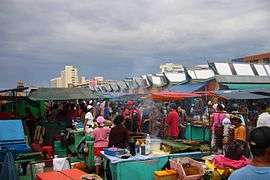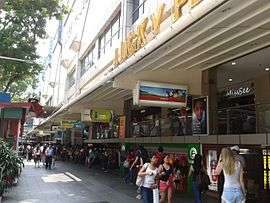Overseas Filipinos
| Total population | |
|---|---|
|
10.2 million | |
| Regions with significant populations | |
| 3,416,844 | |
| 1,020,000[2] | |
| 851,410[3] | |
| 679,819[4] | |
| 325,089[5] | |
| 260,553[6] | |
| 232,386[7] | |
| 195,558[2] | |
| 163,000[1] | |
| 250,000[2] | |
| 186,869[8] | |
| 113,686[9] | |
| 115,362[10] | |
| 112,000[2] | |
| 108,520[11] | |
| 63,464[12] | |
| 40,347[13] | |
| 31,000[14] | |
| 25,000[15] | |
| 20,589[16] | |
| 17,574[17] | |
| 16,719[18] | |
| 14,544[19] | |
| 13,000[20] | |
| 12,791[21] | |
| 12,474[22] | |
| 12,262[23] | |
| 12,254[24] | |
| 10,000'[25] | |
| 8,000[26] | |
| 7,000[27] | |
| 7,000[28] | |
| 4,000[26] | |
| Languages | |
| Languages of the Philippines, English | |
| Religion | |
| Predominantly Christianity (Roman Catholicism, Protestantism & Iglesia ni Cristo) · Islam · Non-religious | |
| Related ethnic groups | |
| Filipinos | |
An Overseas Filipino (Filipino: Pilipino sa Ibayong-dagat) is a person of Filipino origin who lives outside the Philippines. This term applies to Filipinos who are abroad indefinitely as citizens or as permanent residents of a different country and to those Filipino citizens abroad for a limited, definite period, such as on a work contract or as students.
Population
In 2013, the Commission on Filipinos Overseas (CFO) estimated that approximately 10.2 million people of Filipino descent lived or worked abroad.[1] This number constitutes about 11 percent of the total population of the Philippines.[29] It is one of the largest diaspora populations, spanning over 100 countries.[30]
The overseas Filipino workers (OFWs) tend to be young and gender-balanced. Based on a survey conducted in 2011, the demographics indicate how the 24-29 age group constitutes 24 percent of the total and is followed by the 30-34 age group (23 percent) working abroad.[31] Male OFWs account for 52 percent of the total OFW population. The slightly smaller percentage of the female overseas workers tend to be younger than their male counterparts.[31] Production workers and service workers account for more than 80 percent of the labor outflows by 2010 and this number is steadily increasing, along with the trend for professional workers, who are mainly nurses and engineers.[31]
The OFW population is consistently increasing through the years and this is partly attributed to the government's encouragement of the outflow of contractual workers as evidenced in policy pronouncements, media campaigns, and other initiatives.[32] For instance, it describes the OFWs as the heroes of the nation, encouraging citizens to take pride in these workers.
Economic impact
In 2012, the Bangko Sentral ng Pilipinas (BSP), the central bank of the Philippines, expects official remittances coursed through banks and agents to grow 5% over 2011 to US$21 billion, but official remittances are only a fraction of all remittances.[33] Remittances by unofficial, including illegal, channels are estimated by the Asian Bankers Association to be 30 to 40% higher than the official BSP figure.[33] In 2011, remittances were US$20.117 billion.[34]
In 2012, approximately 80% of the remittances came from only 7 countries—United States and Canada, the United Kingdom, UAE and Saudi Arabia, Singapore, and Japan.[34]
Issues
Employment conditions
Employment conditions abroad are relevant to the individual worker and their families as well as for the sending country and its economic growth and well being. Poor working conditions for Filipinos hired abroad include long hours, low wages and few chances to visit family. Women often face disadvantages in their employment conditions as they tend to work in the elder/child care and domestic. These occupations are considered low skilled and require little education and training, thereby regularly facing poor working conditions. Women facing just working conditions are more likely to provide their children with adequate nutrition, better education and sufficient health. There is a strong correlation between women's rights and the overall well being of children. It is therefore a central question to promote women's rights in order to promote children's capabilities.[35][36]
According to a statement made in 2009 by John Leonard Monterona, the Middle East coordinator of Migrante, a Manila-based OFW organization, every year, an unknown number of Filipinos in Saudi Arabia were then "victims of sexual abuses, maltreatment, unpaid salaries, and other labor malpractices".[37]
Government policy
Philippine Labor Migration Policy has historically focused on removing barriers for migrant workers to increase accessibility for employment abroad. Working conditions among Filipinos employed abroad varies depending on whether the host country acknowledges and enforces International labor standards. The standards are set by the ILO, which is an UN agency that 185 of the 193 UN members are part of. Labor standards vary greatly depending on host country regulations and enforcement. One of the main reasons for the large differences in labor standards is due to the fact that ILO only can register complaints and not impose sanctions on governments.
Emigration policies tend to differ within countries depending on if the occupation is mainly dominated by men or women. Occupations dominated by men tend to be driven by economic incentives whereas emigration policies aimed at women traditional tend to be value driven, adhering to traditional family roles that favors men's wage work. As women are regularly seen as symbols of national pride and dignity, governments tend to have more protective policies in sectors dominated by women. These policies risk to increase gender inequality in the Philippines and thereby this public policy work against women joining the workforce.[38]
The Philippine government has recently opened up their public policy to promote women working abroad since the world's demand for domestic workers and healthcare workers has increased. This has led to the government reporting a recent increase in women emigrating from the Philippines. A healthcare problem arises as migrating women from the Philippines and other developing countries often create a nursing shortage in the home country. Nurse to patient ratio is down to 1 nurse to between 40 and 60 patients, in the 1990s the ratio was 1 nurse to between 15 and 20 patients. It seems inevitable that the healthcare sector loses experienced nurses as the emigration is increasing. The Japan-Philippines Economic Partnership Agreement is seen as a failure by most since only 7% of applicants or 200 nurses a year has been accepted on average – mainly due to resistance by domestic stakeholders and failed program implementation. The result is a "lose-lose" outcome where Philippine workers fail to leverage their skills and a worldwide shortage persists. Despite the fact that Japan has an aging population and many Filipinos want to work in Japan, a solution has not yet been found. The Japanese Nursing Association supports "equal or better" working conditions and salaries for Filipino nurses. In contrast, Yagi propose more flexible wages to make Filipinos more attractive on the Japanese job market.[39][40] [41]
Results from a focus group in the Philippines shows that the positive impacts from migration of nurses is attributed to the individual migrant and his/her family, while the negative impacts are attributed to the Filipino healthcare system and society in general. In order to fill the nursing shortage in the Philippines, suggestions have been made by several NGOs that nursing-specializing Filipino workers overseas, locally known as "overseas Filipino workers" (OFWs), return to the country to train local nurses, for which program training would be required in order for the Philippines to make up for all its nurses migrating abroad.[41]
Host country policies
Wealthier households derive a larger share of their income from abroad. This might suggest that government policies in host countries favor capital-intensive activities. Even though work migration is mainly a low and middle class activity, the high-income households are able to derive a larger share of their income from abroad due to favorable investment policies. These favorable investment policies causes an increase in income inequalities and do not promote domestic investments that can lead to increased standard of living. This inequality threatens to halt the economic development as investments are needed in the Philippines and not abroad in order to increase growth and well-being. A correlation between successful contribution to the home country's economy and amounted total savings upon the migrants return has been found, therefore it is important to decrease income inequalities while attracting capital from abroad to the Philippines.[39][42]
Many host governments of OFWs have protective policies and barriers making it difficult to enter the job market. Japan has been known for rigorous testing of Filipinos in a way that make them look reluctant to hold up their part of the Japan-Philippines Economic Partnership Agreement and solely enjoy the benefit of affordable manufacturing in the Philippines, not accepting and educating OFWs.[40]
Return migration
Returning migrant workers are often argued to have a positive effect on the home economy since they are assumed to gain skills and return with a new perspective. Deskilling has caused many Filipino workers to return less skilled after being assigned simple tasks abroad, this behavior creates discouragement for foreign workers to climb the occupational ladder. Deskilling of labor is especially prevalent among women who often have few and low skill employment options, such as domestic work and child or elder care. Other occupations that recently has seen an increase in deskilling are doctors, teachers and assembly line workers.[39]
To underline what a common problem this deskilling is: Returning migrant workers are calling for returnee integration programs, which suggests that they do not feel prepared to be re-integrated in the domestic workforce.[38]
As the Philippines among other countries who train and export labor repeatedly has faced failures in protecting labor rights, the deskilling of labor has increased on a global scale. A strong worldwide demand for healthcare workers causes many Filipinos to emigrate without ever getting hired or become deskilling while possibly raising their salary. The result is a no-win situation for the sending and receiving country. The receiving countries lose as skilled workers are not fully utilizing their skills while the home country simultaneously experience a shortage of workers in emigrating prone sectors.[40]
Countries with Filipino populations































See also
Work Cited
- 1 2 3 4 5 6 7 8 9 10 11 12 "Stock Estimate of Filipinos Overseas As of December 2013" (PDF). Philippine Overseas Employment Administration. Retrieved 2015-09-19.
- 1 2 3 4 Stock Estimates of Filipinos Overseas 2007 Report (archived from the original on 2008-10-10)
- ↑ "Immigrant population in Canada, 2016 Census of Population". Statistics Canada. 2017-10-25. Retrieved 2017-11-03.
- ↑ "Know Your Diaspora: United Arab Emirates".
- ↑ "No foreign workers' layoffs in Malaysia - INQUIRER.net, Philippine News for Filipinos". 9 February 2009. Archived from the original on 9 February 2009.
- ↑ 2017年度在留外国人確定値 (PDF), Japan, 13 April 2018, archived from the original (PDF) on 2018-03-27, retrieved 2018-04-13
- 1 2 "2016 Census QuickStats: Australia". www.censusdata.abs.gov.au.
- 1 2 Filipinos in Hong Kong Hong Kong Bureau of Statistics. Retrieved 27 December 2017.
- ↑ "I cittadini non comunitari regolarmente soggiornanti". 30 November 2013. Archived from the original on 13 November 2014.
- ↑ "PGMA meets members of Filipino community in Spain". Gov.Ph. Retrieved 1 July 2006.
- ↑ 外僑居留-按國籍別 (Excel) (in Chinese). National Immigration Agency, Ministry of the Interior. 2011-02-28. Retrieved 2013-05-21.
- ↑ Filipinos in South Korea. Korean Culture and Information Service (KOIS). Retrieved 21 July 2009.
- ↑ "Ethnic group profiles".
- ↑ "Israeli Central Bureau of Statistics". Israeli Central Bureau of Statistics.
- ↑ Amojelar, Darwin G. (2013-04-26) Papua New Guinea thumbs down Philippine request for additional flights. InterAksyon.com. Retrieved 28 July 2013.
- ↑ "Anzahl der Ausländer in Deutschland nach Herkunftsland (Stand: 31. Dezember 2014)".
- ↑ Vapattanawong, Patama. "ชาวต่างชาติในเมืองไทยเป็นใครบ้าง? (Foreigners in Thailand)" (PDF). Institute for Population and Social Research - Mahidol University (in Thai). Retrieved 25 December 2017.
- ↑ "A brief history of Philippine – Netherlands relations". The Philippine Embassy in The Hague. Archived from the original on 2009-02-15.
- ↑ "Macau Population Census". Census Bureau of Macau. May 2012. Retrieved 22 July 2016.
- ↑ "pinoys-sweden-protest-impending-embassy-closure". ABS-CBNnews.com.
- ↑ "CSO Emigration" (PDF). Census Office Ireland. Retrieved 29 January 2013.
- ↑ "Statistic Austria".
- ↑ "8 Folkemengde, etter norsk / utenlandsk statsborgerskap og landbakgrunn 1. januar 2009". Statistisk sentralbyra (Statistics Norway). Archived from the original on 2009-05-15. Retrieved 3 February 2014.
- ↑ "President Aquino to meet Filipino community in Beijing". Ang Kalatas-Australia. 30 August 2011.
- ↑ "Backgrounder: Overseas Filipinos in Switzerland". Office of the Press Secretary. 2007. Archived from the original on 7 September 2008. Retrieved 23 October 2009.
- 1 2 Embassy of Kazakhstan in Malaysia website Archived 2013-11-11 at the Wayback Machine.. Kazembassy.org.my. Retrieved 28 July 2013.
- ↑ "From Philippines to Pakistan: Maids can be brought in for only a few thousand rupees - The Express Tribune". 24 February 2013.
- ↑ Tan, Lesley (2006-06-06). "A tale of two states". Cebu Daily News. Archived from the original on 2013-02-22. Retrieved 11 April 2008.
- ↑ McKenzie, Duncan Alexander (2012). The Unlucky Country: The Republic of the Philippines in the 21St Century. Bloomington, IN: Balboa Press. p. 138. ISBN 9781452503363.
- ↑ David K. Yoo; Eiichiro Azuma (4 January 2016). The Oxford Handbook of Asian American History. Oxford University Press. p. 402. ISBN 978-0-19-986047-0.
- 1 2 3 IMF (2013). Philippines: Selected Issues. Washington, D.C.: International Monetary Fund Publication Services. p. 17. ISBN 9781484374061.
- ↑ Rupert, Mark; Solomon, Scott (2006). Globalization and International Political Economy: The Politics of Alternative Futures. Lanham: Rowman & Littlefield. p. 88. ISBN 0742529436.
- 1 2 Remo, Michelle V. (14 November 2012). "Stop illegal remittance agents, BSP urged: Informal forex channels a problem in the region". Philippine Daily Inquirer.
- 1 2 Magtulis, Prinz (15 November 2012). "Remittance growth poised to meet full-year forecast - BSP". The Philippine Star.
- ↑ UN (2007). " A call for equality.". The state of the worlds children. pp. 1–15. Retrieved 2014-05-18
- ↑ "Gender and Migration: An Integrative Approach eScholarship]". Escholarship.org. Retrieved 2014-07-09.
- ↑ Leonard, John (2008-07-03). "OFW rights violation worsens under the Arroyo administration". Filipino OFWs Qatar. Archived from the original on 2009-01-07. Retrieved 2009-01-25.
- 1 2 Oishi, N. (March 2002). "Gender and migration: an integrated approach". Escolarship.org.
- 1 2 3 Beneria, L. Deere; Kabeer, C. (2012). "Gender and international migration: globalization, development and governance".
- 1 2 3 Nozomi, Y. (February 2014). "Policy review: Japan-Philippines economic partnership agreement, analysis of a failed nurse migration policy".
- 1 2 Lorenzo, E. (June 2007). "Nursing migration from a source country perspective: Philippine country case study" (PDF). Health Serv Res. 42: 1406–18. doi:10.1111/j.1475-6773.2007.00716.x. PMC 1955369. PMID 17489922.
- ↑ "Migration and Foreign Remittances in the Philippines". IMF working paper: Asia and Pacific department. p. 3.
- ↑ Immigrants in Denmark, 2016 Census
- ↑ "Wives wanted in the Faroe Islands" by Tim Ecott, BBC News, 27 April 2017
- ↑ http://pxnet2.stat.fi/PXWeb/pxweb/en/StatFin/StatFin__vrm__vaerak/statfin_vaerak_pxt_013.px/?rxid=726cd24d-d0f1-416a-8eec-7ce9b82fd5a4
- ↑ Catolico, Gianna Francesca (29 September 2016). "Filipinos 3rd largest group in Japan—report". Philippine Daily Inquirer. Retrieved 6 November 2017.
- ↑ "Qatar´s population by nationality". BQ Magazine. 18 Dec 2013. Archived from the original on 2013-12-22.
- ↑ "Filipinos in Liverpool, Part 1". Filipinohome.com. 1915-05-04. Retrieved 2014-07-09.
- ↑ Rueda, Nimfa U. (25 March 2012). "Filipinos 2nd largest Asian group in US, census shows". Philippine Daily Inquirer. Retrieved 17 February 2017.
Kevin L. Nadal (23 March 2011). Filipino American Psychology: A Handbook of Theory, Research, and Clinical Practice. John Wiley & Sons. p. 17. ISBN 978-1-118-01977-1.
Min Zhou; Anthony C. Ocampo (19 April 2016). Contemporary Asian America (third Edition): A Multidisciplinary Reader. NYU Press. p. 292. ISBN 978-1-4798-2923-1. - ↑ "Historic Filipinotown - Things to Do". VisitAsianLA.org. Retrieved 2014-07-09.
- ↑ "Background Note: Philippines". U.S. Department of State: Bureau of East Asian and Pacific Affairs. May 2007. Retrieved 2007-09-02.
There are an estimated four million Americans of Filipino ancestry in the United States, and more than 250,000 American citizens in the Philippines.
Further reading
- Terry, William. "The perfect worker: discursive makings of Filipinos in the workplace hierarchy of the globalized cruise industry". Social & Cultural Geography. 15 (1): 73–79. doi:10.1080/14649365.2013.864781. Retrieved 5 March 2007.
External links
| Wikimedia Commons has media related to Filipino diaspora. |
General statistics from Philippine government
- POEA2004 a b c d e f g h i "Stock Estimate of Filipinos Overseas". Philippine Overseas Employment Administration. 2004. Archived from the original (MS Excel) on 2005-12-18. Retrieved 2007-08-01.
(overseas Filipinos working and/or living overseas):
- 3,187,586 stay permanently, 3,599,257 stay for work contracts, and 1,296,972 stay irregularly (without proper documents), which make a sum of 8,083,815.
- Press release on the 2004 Survey on Overseas Filipinos, Philippine Statistics Authority, on OFWs:
- 1.06 million Overseas Filipino Workers
- 33.4% are unskilled workers, 15.4% are Trades and related workers, 15.1% are plant and machine operators and assemblers.
- 49.3% are males, 50.7% are females.
- Remittances are 64.7 billion Philippine pesos (equaled 1.2 billion USD then)
- Deployed Landbased Overseas Filipino Workers by Destination (New hires and Rehires) (MS Excel format), Philippine Overseas Employment Administration, 2005, on OFWs:
- 733,970 are landbased, 247,707 are seabased, which make a sum of 981,677. There is a 5.15% growth since 2004's 933,588.
- Remittances are 9,727,138,000 USD. There is a 26.6% growth since 2004.
- List of Additional Reports from the Philippine Overseas Employment Administration Statistics Page
From other sources
- a b AUS - "1301.0 - Year Book Australia, 2012 - Population - Country of Birth". Australia Bureau of Statistics. 2012. Retrieved 2013-08-30. .
- a GWM - "Country Profile: Guam - People". CIA Factbook. Retrieved 2007-05-12. .
- a LBN - Maila Ager (3 August 2006). "'Standby fund' for OFWs in Lebanon gets House committee nod". Philippine Daily Inquirer. Archived from the original on 11 October 2007. Retrieved 2007-05-09. .
- a NZL - "QuickStats About Culture and Identity". Statistics New Zealand Tatauranga Aotearoa. 3 August 2006. Archived from the original on 2007-08-29. Retrieved 2007-05-12. .
- a SAU - "Table 29. Stock Estimate of Filipinos Overseas As of December 2006" (PDF). Philippine Overseas Employment Administration. 2006. Archived from the original (PDF) on 2012-02-08. Retrieved 2007-09-01. .
- a b TWN - Alien Workers in Taiwan-Fukien Area by Industry and Nationality (JPG and PDF format), 2006 February, CLA, Taiwan.
- a MAL - "Table 29. Stock Estimate of Filipinos Overseas As of December 2006" (PDF). Philippine Overseas Employment Administration. 2006. Archived from the original (PDF) on 2012-02-08. Retrieved 2007-09-01. .
- USA
- a1 "Selected Population Profile in the United States - Population Group: Filipino alone or in any combination". U.S. Census Bureau. 2005. Retrieved 2007-05-09.
Population Group: Filipino alone or in any combination - Total population: 288,378,137
. - b1 b2 United States Census Bureau (2007). "Background Note: Philippines". U.S. Department of State, Bureau of East Asian and Pacific Affairs. Retrieved 2006-11-04.
There are an estimated four million Americans of Filipino ancestry in the United States, and more than 250,000 American citizens in the Philippines.
- a1 "Selected Population Profile in the United States - Population Group: Filipino alone or in any combination". U.S. Census Bureau. 2005. Retrieved 2007-05-09.
- a ARE – Jose N. Franco Jr (28 April 2007). "Jan–Feb 2007 remittances by Filipinos in Dubai grow 96pc". Khaleej Times. Retrieved 2007-05-09.
- a AUS – "Year Book Australia, 2007 Contents >> Population >> Country of birth". Australia Bureau of Statistics. 2007. Retrieved 2007-08-08.
- a CAN – "Population by Ethnic Origin". Asia Pacific Foundation of Canada. Archived from the original on 2007-04-09. Retrieved 2007-05-08.
- a GWM – "Country Profile: Guam – People". CIA Factbook. Retrieved 2007-05-12.
- a IRL – Central Statistics Office Ireland. "Principal Statistics of Ireland by nationality". Retrieved 2007-04-12.
- a ITA – Lawrence Casiraya. "Microsoft training centers cater to 200,000 OFWs in Italy". Philippine Daily Inquirer. Retrieved 2007-08-14.
- a JPN – "Undocumented Filipinos cross the great divide in Japan". Philippines Today. Retrieved 2007-05-09.
- a LBN – Maila Ager (3 August 2006). "'Standby fund' for OFWs in Lebanon gets House committee nod". Philippine Daily Inquirer. Archived from the original on 11 October 2007. Retrieved 2007-05-09.
- a NZL – "QuickStats About Culture and Identity". Statistics New Zealand Tatauranga Aotearoa. 3 August 2006. Archived from the original on 2007-08-29. Retrieved 2007-05-12.
- a ROK – "Secretary Albert Assures Filipinos in Korea of Continued Government Protection for Their Interests". Philippine Department of Foreign Affairs. 3 August 2006. Archived from the original on 2007-08-05. Retrieved 2007-05-12.
- a SAU – "International Religious Freedom Report 2005 – Saudi Arabia". Bureau of Democracy, Human Rights, and Labor, U.S. Department of State. 2005. Retrieved 2007-05-09.
- a TWN – Alien Workers in Taiwan-Fukien Area by Industry and Nationality (JPG and PDF format), 2006 February, CLA, Taiwan.
- USA
- a1 "Selected Population Profile in the United States – Population Group: Filipino alone or in any combination". U.S. Census Bureau. 2005. Retrieved 2007-05-09.
Population Group: Filipino alone or in any combination: 2,807,731
- b1 United States Census Bureau (May 2007). "Background Note: Philippines". U.S. Department of State, Bureau of East Asian and Pacific Affairs. Retrieved 2007-09-02.
There are an estimated four million Americans of Filipino ancestry in the United States, and more than 250,000 American citizens in the Philippines.
- a1 "Selected Population Profile in the United States – Population Group: Filipino alone or in any combination". U.S. Census Bureau. 2005. Retrieved 2007-05-09.
- Overseas Filipino
